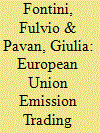| Srl | Item |
| 1 |
ID:
187913


|
|
|
|
|
| Summary/Abstract |
Sustained economic growth and environmental degradation are two of the key goals in the SDGs (Sustainable Development Goals). Digital finance provides an opportunity to simultaneously address the trade-off between the two goals. Based on data from CEADs, CNBS, CFPS, IDFPU, VIIRS and NPCGIS, this article examines the causal impact and transmission mechanisms of digital finance on consumption-based HCEs. To address the potential endogeneity, IV and IV-MA as well as HDFE models are applied in empirical estimates. Results show that digital finance has a positive impact on consumption-based HCEs. Mechanism analysis indicates that digital finance can increase HCEs through stimulating consumption scale, which is scale effect. Besides, digital finance can decrease HCEs through promoting greener consumption patterns, which is composition effect. On the whole, scale effect prevails composition effect. Our findings contribute to the literature on digital finance and green finance and have policy implications on common prosperity, not only for China, but also for other economies.
|
|
|
|
|
|
|
|
|
|
|
|
|
|
|
|
| 2 |
ID:
133312


|
|
|
|
|
| Publication |
2014.
|
| Summary/Abstract |
We evaluate the contribution of technological change in reducing CO2 emissions in the Italian pulp and paper industry during the first and second phases of application of the European Union Emission Trading System (EU-ETS). We decompose the variation in emission and emission intensity into three different types of effects: a composition effect, a technique effect and a scale effect. The composition effect measures the change in emissions and emissions intensity due to a shift in production towards products that cause less emissions. The technique effect measures the change per each type of product, thereby accounting for technology improvements in the production of each type of good produced. The scale effect singles out the reduction in total emission due to an overall reduction in output. We show that the first phase of the application of EU-ETS has led to a reduction in both emissions and emission intensity due to the composition effect. The technological change has had a limited negative impact on emissions in the first phase, while in the second phase there has been limited technology improvement in the industry. However, the figures of the scale effect show that the larger reduction in emission is due to the overall decrease in output.
|
|
|
|
|
|
|
|
|
|
|
|
|
|
|
|